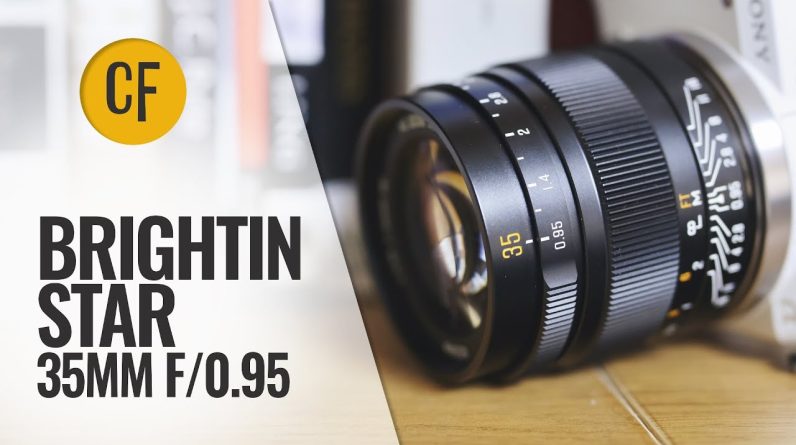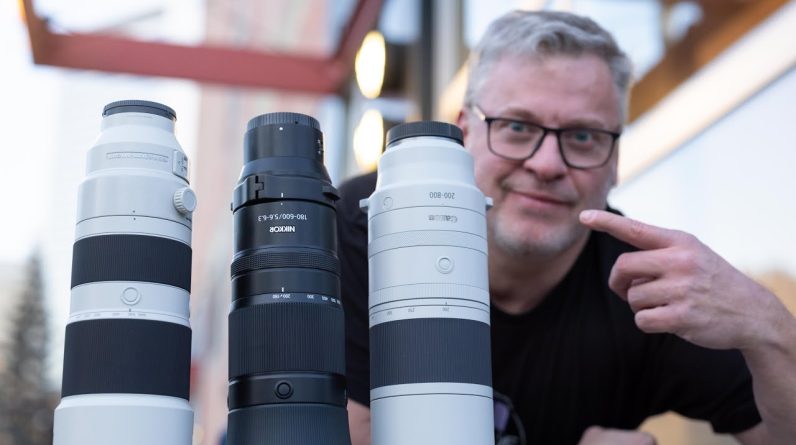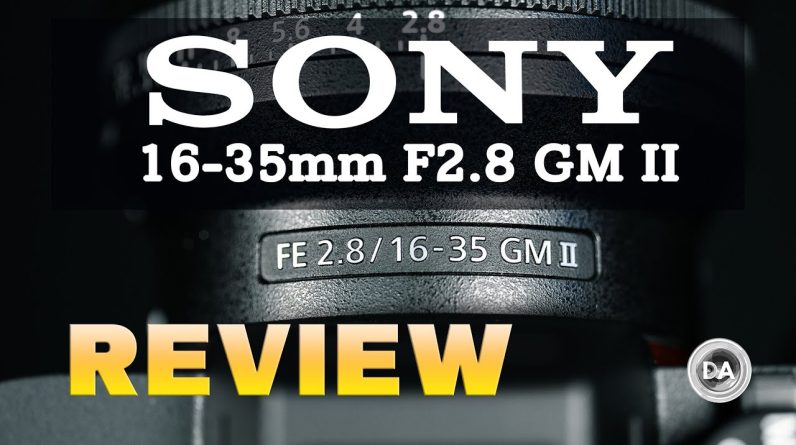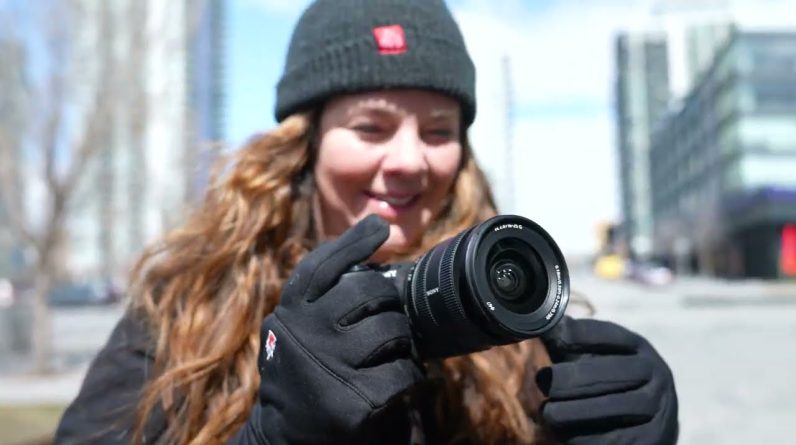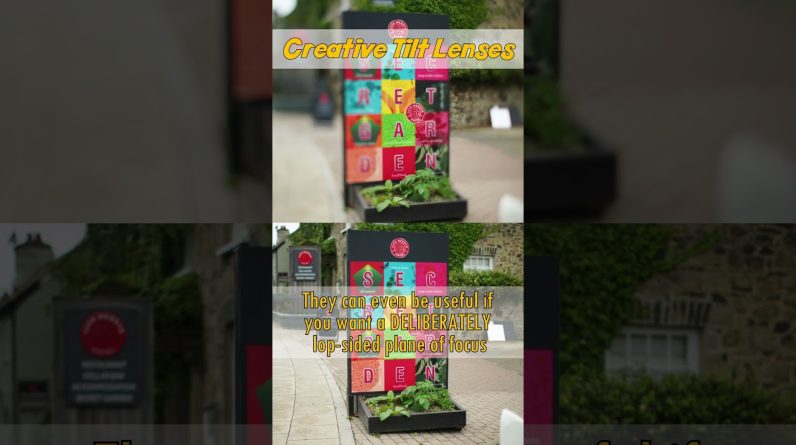[Music] Foreign Hi I'm Dustin Abbott and I'm here today To give you my video review of the Fujinon XF 33 millimeter F 1.4 R lmwr And I'll break down what that means in Just a moment now instead of showing you The lens in front of you I actually am Filming on it I wanted to do this Because it's been a little while since I've actually filmed any reviews on a Fuji camera because in times past it Would be so inconsistent for tracking my Face but I thought it'd be a good time To show how that Fuji has really Advanced a long way in this so I'm Filming on the xh2 at the moment with The 33 millimeter F 1.4 now the XF 33 Millimeter F 1.4 is Fuji's fourth normal Prime lens in that they've had three Previous with a slightly different focal Length of 35 millimeters 33 millimeters Actually more closely corresponds to the 50 millimeter or normal standard and so This is in some ways this is the truest Normal lens if you consider a 50 Millimeter the normal standard this is The closest to what they have had to This point now it is the largest and the Most expensive of these four lenses to Date however it is also the most Consistently good of the Ford it Combines a still compact size with very Good and I will note very balanced optic
Optical performance it has good Autofocus with their linear motor Autofocus system and it has a very nice Build however it is also as noted the Most expensive at around 800 US Dollars And so is this lens worth that asking Price well we'll answer that question in This review right after a word from our Sponsor Today's episode is brought to you by Phantom wallet the minimalist modern Wallet that is now even better with the New Phantom X that is crafted from Aluminum right here in Canada it is 22 Percent smaller and 35 percent lighter While still making it easy to access Your cards and money when you need them Thanks to their unique Fanning mechanism You could even customize your wallet due To its modular design with accessories Like a money clip cash holder ID display And even chipolo and air tag tracking Integration visit Store.phantomwallet.com to check out Their unique sizes Styles and finishes That span from aluminum to Wood to Carbon fiber and use code Dustin 15 for 15 off when you're ready to check out So to break down what the naming Initials mean so R refers to aperture Ring or ring and so in this case we have Fuji standard approach to aperture and That you have an aperture Iris that can Be controlled either manually or from
Within the camera if you control it Manually there are one third stop to Tenths with markings at the full Aperture stops in this case f 1.4 F2 F 2.8 and so on and what we don't have However is a d-click option which has Become more and more standard on some Other brands the ability to de-click That aperture LM stands for linear motor Which refers to the focus system which We'll get to in just a moment WR refers To the fact that it has weather Resistance and so that as a gasket at The rear mount and also some internal Seals inside as a part of that giving us A premium build and a premium design Here as noted this is a little bit Larger and heavier than some of the Predecessors however this is still quite A moderately sized lens it is 67 Millimeters in diameter with a 58 Millimeter front filter thread and just 73 and a half millimeters long that's 2.6 inches by 2.9 inches and it weighs In at 360 grams or 12.7 ounces this is Still a lens you're easily going to be Care be able to carry all day and shoot With and not get bogged down with the Weight of it it is slightly larger and Heavier than the two XF Mount 33 Millimeter F 1.4 Alternatives there's One from viltrox also one from tokina Very slightly heavier and larger than Those but as you can see in this picture
Of it next to the viltrox it is subtle Enough that you might not quickly pick That up it's definitely not anything Major in One Direction or the other Beyond the aperture ring there is the Manual focus ring and it moves smoothly With a reasonable amount of damping Though as always this is focused by wire So it's you know not going to feel like A true manual focus lens there is a very Nice finish it's a durable metal feels Good but the one kind of exception to The quality of the build is the lens Hood itself the lens hood is plastic and So and it doesn't even have a completely Matching finish and so it feels a little Bit discordant like it's tacked on and I Also note that the kind of finish that It does have seems to be really prone to Picking up fingerprints and also marks Along the way so I would have preferred It to be more of a matching finish kind Of like what viltrox did with their much Less expensive 33 millimeter F 1.4 also In the negative column is not so much a Deviation from the pattern of what we've Seen from this type of Fuji lens in the Past but more that we haven't deviated From that pattern and that we still have Really no features outside of the Aperture on the lens itself there's Nothing like a equivalent of a Sony or Canon Focus hold button as no to no D-click options there's not really any
Of these other features that have become More and more standard and when you Consider that this is a lens that Retails for 800 US dollars It seems like an Omission at this point It's time for Fuji to kind of raise the Bar or at least meet the standard that's Being set by other manufacturers inside We have nine rounded aperture blades That does quite a good job of Maintaining a circular shape as you can See as it stopped down also we have a Minimum Focus distance of 30 centimeters Giving us a maximum magnification of 0.15 times that's about average for a 50 Millimeter ish lens which is what this Essentially is but it's nothing Exceptional but when you compare it to The other 33 millimeter F 1.4 options From viltrox or tokina both of those Have a really substandard 0.1 times Magnification makes it look pretty good By comparison Let's talk about autofocus for a moment We do have the linear Focus motor here As a part of this design and I will note That the autofocus is quite Snappy on The xh2 as you can see here it's making Even major Focus changes with you know Good quickness there and not any kind of Pulsing or hunting I will note that when The motor itself seems quite quiet but What isn't completely quiet is the Aperture blades and so you'll hear them
Kind of clicking or snapping and making Some noises they open and close during The actual autofocus process Also I found that there was very good Eye stickiness you can see from this Shot that as I pan around around Nala That obviously it grabs the eye as soon As the eye is available and it tracks it Very efficiently as I move around with The camera also when it came to doing my Hand test the stickiness was so much That I actually had a hard time as you Can see getting it to move away from my My face and so I basically had to Obscure my face all together before Focus would shift from it and so Obviously eye stickiness being a Strength and I did find that iaf worked Well with several different subjects Over the course of my review and so That's a technology that certainly has Been improved by Fuji and of course the Fact that they now have the AI learning Really helps with predictive tracking of Those things which has made a huge Difference in that overall stickiness And which is a big part of why I feel Confident filming on a Fuji camera which I didn't in times past I also also note That my focus pools were nicely damped And quiet you will see that there is Just a little bit of a step there at the End it's as if Focus gets to a certain Point pauses just for a split second and
Then it kind of does that final little Pull to the Final Destination point on The plus side I see very very little Focus breathing there and so that is a Plus for those that want to do video With a lens like this overall while this Isn't the best Focus uh performance that I've ever seen it certainly is Competitive with what I'm seeing with a Lot of other lenses and so I would say That we're certainly making progress From what I saw in times past this is a Much smoother more sophisticated focused Experience than what I've seen from the Older Fuji prime lenses in the past so How about the optical performance this Is a lens that I actually really enjoyed I felt like it struck a very good Balance between sharpness and overall Rendering and so we're going to dive in And we're going to break down how this Holds up even when put against the very Challenging 40 megapixel sensor of the Xh2 let's take a look first of all we'll Take a look at vignette and Distortion Here so on the left I have an Uncorrected raw image on the right I Have what would be automatically Corrected now as I like to do I like to Dial in a manual correction which we've Now got on the right because that allows Me to actually get under the hood and See what would be required for Correction and how linear or non-linear
Distortion is so you can see a bit of Pin cushion Distortion here and also Some vignette in the corners let's crack That open and see what it takes to fix Now as you can see the Distortion was Very linear in nature I was able to get A very clean manual correction at -5 And then also we can see here that Vignette is at plus 62 so that's right Under two and a half stops and and so Not anything too terrible or right about Two and a half stops I would say and you Can see also it was not it's fairly Linear as well so easy to correct and Also means that it can give you a decent Look if you so want it in certain images Now I didn't see any kind of Longitudinal chromatic aberrations pop Up in real world images and so when I Went hunting for them I really didn't Find a whole lot and so we've got some You know bright shiny surfaces here and Then we've also got an out of focus Window no issue there if I take a look Here where we've I've got some shiny and Reflective surfaces we can see that There is a little bit of a fringing in Kind of the Boca region there and so but Again not very pronounced overall fairly Neutral so a pretty strong performance There then if we look for lateral Chromatic aberrations near the edge of The frame there is no correction that's On here and so this is just out of the
Camera we can see that there is only the Slightest slightest hint of any kind of Lateral chromatic aberration so it's not Going to be any kind of real world issue At all so here's a look at my test chart That we'll get our results for our Overall resolution and contrast here now I will note that the 40 megapixel Resolution point on an aps-ce sensor is Basically the most demanding sensor that I've actually ever tested anything on in Terms of pixel density so this is a Serious challenge now I will note one Other thing for at least the Wide Open Results I've gone the extra layer of Doing an enhanced work in um in Lightroom here if we look at 200 Magnification which is the way that I do These tests you can see that on the Right that you know when you go to Sharpen Fuji images sometimes it can get Just a little bit squirrely it's not as Bad as what it used to be but if you go To the enhanced it does give you just a Little bit cleaner result and so I'm Going to use that for the wide open just To give us a benchmark just gives you a Little bit cleaner sharpening and Overall end result if we take a quick Look at the MDF chart it suggests a very Sharp Center and then a significant drop Towards the center and then kind of a Flat line over to the edge looking at Our actual test chart we see that the
Center of the frame does look very nice And crisp even at F 1.4 even at this Very high resolution point and we can See that yes the mid frame is not as Crisp and not as high contrast as what We saw but then if we go down towards The corner we can see that yes it is Virtually about the same here as it is Down here so not really any kind of Significant fade towards the edges so if I compare to the one point of comparison I do have on hand which is the viltrox 33 millimeter F 1.4 exact same specs Basically here we can see that the Fuji Is the easy winner here the viltrox Looks much more mushy by comparison even Though I've also got the enhanced Version here that's true in the center It's true in the mid frame it is true Down into the corner as well so Definitely you know this is a case of Probably you get what you pay for here Now a test chart at 200 percent can be a Bit murder so let's take a look at how That looks in the real world here at F 1.4 we can see on Ferrari here that's a Very crisp result 40 megapixels that's Very demanding but yet it's doing a Really great job there we can take a Look here at this lichen or moss growing Along on the rock you can see once again Very very good contrast is not bad at All and you can see a nice transition to Defocus as well which we'll talk more
About in just a moment some early spring Buds here and we can see if we go into 100 magnification we've got a nice Detail popping up there so good results So far and then here's a nighttime image A little bit higher ISO obviously Because of shooting at night but we can See that if we go into a pixel level Even at F 1.4 we've got you know quite Good detail and certainly usable Contrast throughout the image and so Very very useful amount of resolution It's actually a very good match for this Higher resolution sensor one final wide Open Result kind of one of my nature Shots here and you can see very nice Crisp detail and contrast there a very Nice looking image So going back to the test and now I'm Going to use the non-enhance just to Give you a point of comparison as we Stop down we can see that F at F 1.8 There's a little bit more contrast Um you can see just a little bit more Detail there in the mid frame if we pop Down into the corner you can definitely See a significant Improvement in the Contrast and that we're starting to get A little bit more detail resolving there At the edge of the frame Moving on down to F2 we can see that That improves just a little bit further And at F 2.8 we're just starting to get More detail we'll pop back to the center
Here Center looking fantastic here at F 2.8 and we can see now that the mid Frame is starting to look a lot better You can just see more detail starting to Show up in different spots in the frame As we begin to stop on Dam from F 2.8 to F4 just a little bit more pop there it's Really more in the corner where we're Starting to see the detail as you can See comparing here and here for example That the detail is just starting to get Stronger and stronger so if we check Back in with the viltrox here at F4 we Can see that in the center of the frame The viltrox has improved considerably It's now quite sharp very good contrast And you know it's fairly comparable to The Fuji that's true also in the mid Frame here on the right side though the Fuji obviously is delivering just kind Of a brighter better contrast result Just a little bit cleaner looking down On the corner however the viltrox much Weaker by comparison and also I did note That if I look kind of at the centering That the Fuji is definitely the better Lens in terms of consistency on both Sides of the frame there you know a more Expensive lens sometimes results in a Better Optical design and a little bit More consistent quality control Now going back to real world results Here at F 5.6 we can see that in the Center of the frame we're just getting
Lots and lots of information in all of These you know different pine needles And bear branches right off to the edge Of the frame we've got nice detail here This is a lens now that is going to Really deliver for landscape type images Or smaller aperture images Now on the high resolution bodies like This I would typically look at about f8 As the limit is how high I would want to Go before you start to experience Diffraction and as you can see here our Minimum aperture is F16 but you can see That there's been a serious hit even Compared to F 1.4 in terms of contrast And the ability to run render fine Details diffraction is just a physical Reality that on a high resolution body Is going to really punish you and so I Would use as a practical range when at All possible go from F 1.4 to about f8 Here if you're using the high resolution Bodies now our minimum Focus distance of 30 centimeters and maximum magnification Of 0.15 is nothing particularly Impressive that's what I would consider About average for a 50 millimeter lens On full frame which is is the equivalent Of it does deliver quite good Performance up close you know contrast Details pretty good Um you know contrast could be a little Bit better but really not too bad where This kind of shines those in comparison
To the either the viltrox 33 millimeter F 1.4 of the tokina 33 millimeter F 1.4 The two kind of main exact competitors Both of those lenses only deliver a 0.10 Times and so this is obviously a much Use more useful figure than that and if I take a look at a real world shot here You can see that it's enough to get Close and to really blur out a Background and with a real world Three-dimensional object you know Contrast isn't off the charts it's not a Macro level but there's a nice amount of Detail there in the very narrow plane of Focus and obviously a very nice defocus Beyond that Taking a quick look here at the geometry Of the lens wide open F 1.4 very nice Bokeh circles in the center of the frame Some deformation towards the edge of the Frame though not extreme you can see That they become more oval than Completely cat eye stopping on down to F2 we can see that we're starting to get A little bit more consistent circular Shape across the frame it's not really Until F 2.8 however that you get close To you know full circles all across the Frame if that's something that's a Priority to you we can see that we are Retaining a nice circular shape you can Very vaguely see the nonagonal shape of The nine aperture blades but it is Pretty well masked and so byproduct is
Is this lens aperture is doing quite a Good job when it comes to specular Highlights like this now we've seen if You're really up close you can really Blur out a background this is a really Complex shot here with a lot of hard Edges and it's you know not completely Free from some Jitter but overall I Would say that that has handled that Setting quite well and if we look again In more friendly settings like this We've got good detail on the subject the Lock here you know looks nice good Contrast on the subject and then the you Know blur in the background looks nice Here's stop down to F 2.8 obviously That's going to deliver even higher Resolution and contrast but what we can Also see is that we've got those nice Round circular shapes everywhere we look In the specular highlights Here's a monochrome and of the lock here So you have a very fine line of you know Your depth of field I think this is an Acros Um profile here and byproduct is that You know you have a really nice look Look to be focus and this is kind of What people love about Fuji is the Ability to have some of these film Simulations and to get shots like this That look maybe like they were taken on Film finally taking a quick look at Putting the sun into the frame it's not
Completely exempt from flare artifacts I've seen very little in terms of actual Like ghosting artifacts but you can see That we do have some loss of contrast uh I frankly looks somewhat artistic in This shot and so I didn't see anything That was critical during my review Period so in summation this is a lens That yes is heavier and it's more Expensive than what we've seen both from Fuji previously and then also with the Third party competitors but I also feel Like this is a better lens it is more Sophisticated it's more nuanced and it Delivers frankly nicer image quality Than what I have seen from any of the Other competitors in the past the Cheaper competitors I can't speak for The tokina but certainly for the viltrox It's just not really in the same class And we found that for the centering I Also found just in the general Nuance of Color rendition the Fuji colors are just So much nicer than what the older Viltrox lens was I think viltrox is Getting much better in the this regard And if their recent Pro AF 75 millimeter F 1.2 is any indication they're moving Into a the next level of their length Design but at least on that 33 Millimeter I just feel like the Fuji is Delivering much more pleasing images to My eye I think the probably the best plus that
I could give to this lens or praise that I could give to it is the fact that it Is on my personal short list I'm Actually planning on buying the xh2 it's The camera body from Fuji that you know Finally checks enough of the boxes that I feel like it's what I would like to Own for testing on but also for using in The aps-c space And so the XF 33 millimeter F 1.4 is Certainly on my own personal short list Of Fuji lenses that I would like to Acquire in the future and if I'm ready To open my own wallet and buy it I would Say that's probably the highest praise That I could give it this is a lens that I think is going to Delight a lot of People if you're willing to save up just A little bit more and get what I think Is the better lens I'm Dustin Abbott if You look in the description down below You can find linkage to my full text Review there also to an image gallery if You want to look at some of the photos That I've taken with it there's some Buying links there if you'd like to Purchase one also links to follow myself For Craig on social media you can become A patron get channel merchandise if you Haven't already please like And Subscribe thanks for watching have a Great day and let the light in [Music] Foreign

